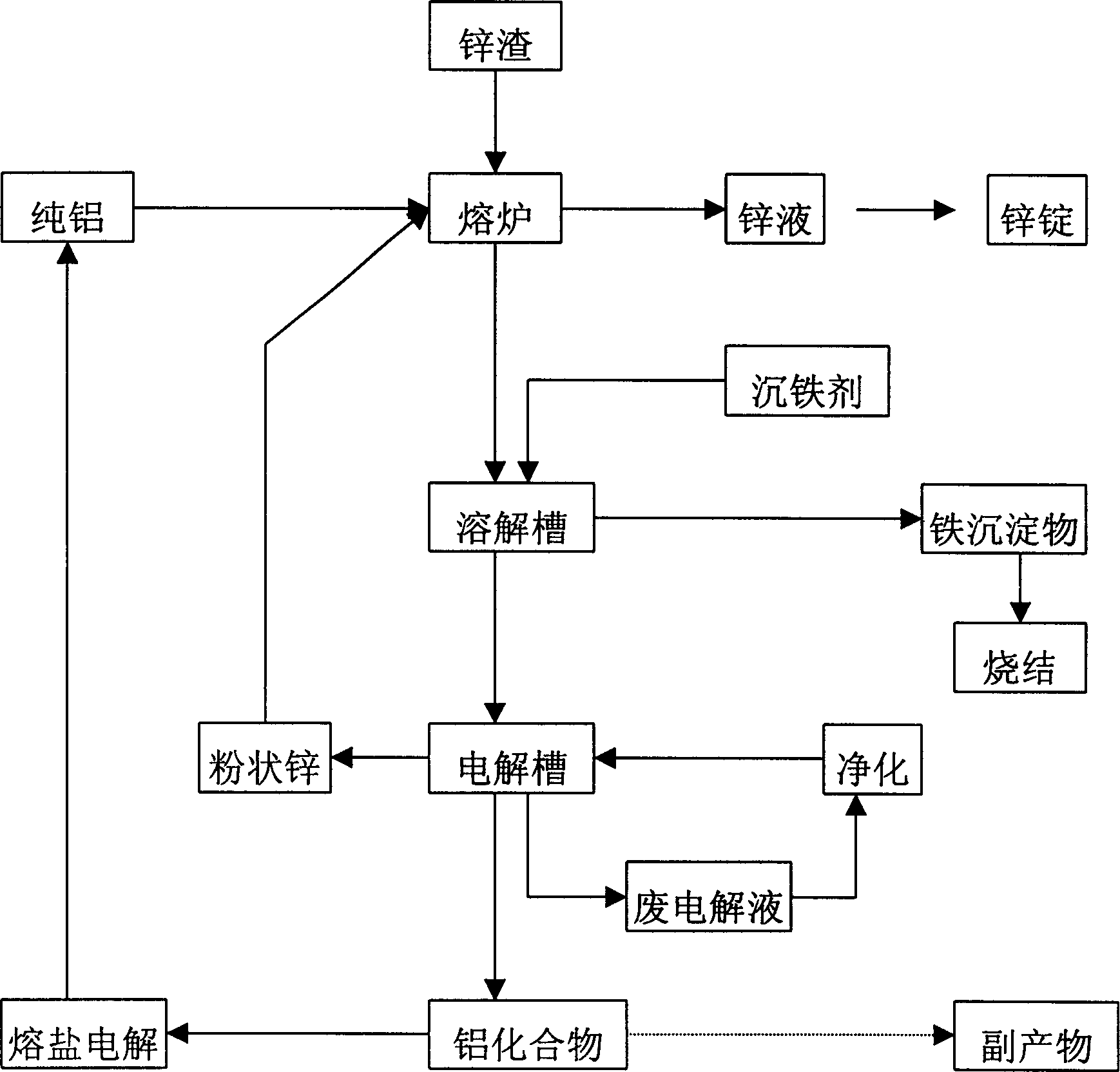Regeneration process of zinc residue produced in hot zinc plating
A hot-dip galvanizing and new process technology, which is applied in the field of zinc slag regeneration new process, can solve the problems of serious environmental pollution, large waste discharge, high energy consumption, etc., achieve low investment, reduce raw material and energy consumption, and small volume Effect
- Summary
- Abstract
- Description
- Claims
- Application Information
AI Technical Summary
Problems solved by technology
Method used
Image
Examples
Embodiment 1
[0025] (a), get 5000 grams of hot-dip galvanizing slag of Baosteel 2030, its chemical composition is as follows: AL7.1%, Pb0.15%, Fe3.4%, Zn88.5%, Cd0.11%. use NH 4 CI is used as a protective medium, heated to 680°C in a furnace to melt, add 80 grams of aluminum and zinc slag liquid to mix, add ammonium chloride, keep the temperature for 1 hour, slowly cool down to 460°C, and stand still for 15 minutes to obtain a homogeneous The zinc liquid directly flows into the ingot casting device to form a zinc ingot weighing 3,500 grams. Zinc ingot composition analysis: AL (%) 0.30 ~ 0.58, Pb (%) 0.02 ~ 0.10, Fe (%) < 0.01, Cd (%) < 0.01, Zn (%) balance.
Embodiment 2
[0027] (a), with embodiment 1.
[0028] (b), the scum separated by step (a) directly enters the dissolving tank, dissolves in the sulfuric acid solution in the dissolving tank, adopts the goethite method to precipitate and remove iron impurities, and can directly send ironmaking after the precipitation is dried.
[0029] (c), the purified lysate is sent to the electrolytic cell, the cell voltage is 0.66v, and the current intensity is 450A / m2. The cathode is nickel, the anode is lead, and the electrolyte is zinc sulfate-sulfuric acid. After electrolysis, 700 grams of zinc are collected on the cathode, and the purity is greater than 99.5%. After being washed and dried, it is sent to the furnace in step (a). The aluminum in the electrolyte is crystallized by distillation to obtain aluminum sulfate. Pure aluminum can be obtained by molten salt electrolysis.
Embodiment 3
[0031] (a), get 5000 grams of hot-dip galvanizing slag of Baosteel 2030, its chemical composition is as follows: Al6.3%, Pb0.15%, Fe2.3%, Zn91.2%, Cd0.11%. Use NH4CI as a protective medium, heat to 810°C in a furnace to melt, add 55 grams of aluminum and zinc slag liquid to mix, keep the temperature for 1 hour, then slowly cool down to 460°C, and stand still for 15 minutes to obtain a homogeneous zinc liquid at the bottom. The zinc liquid flows directly into the ingot casting device to form a zinc ingot weighing 3800 grams. Zinc ingot composition analysis: AL (%) 0.30 ~ 0.58, Pb (%) 0.02 ~ 0.10, Fe (%) < 0.01, Cd (%) < 0.01, Zn (%) balance. The direct recovery rate of zinc is nearly 80%.
[0032] (b) The scum directly enters the dissolving tank, dissolves in the hydrochloric acid solution in the dissolving tank, adopts goethite precipitation to remove iron impurities, and can be directly sent to ironmaking after the precipitation is dried.
[0033] (c), the purified solution...
PUM
 Login to View More
Login to View More Abstract
Description
Claims
Application Information
 Login to View More
Login to View More - R&D Engineer
- R&D Manager
- IP Professional
- Industry Leading Data Capabilities
- Powerful AI technology
- Patent DNA Extraction
Browse by: Latest US Patents, China's latest patents, Technical Efficacy Thesaurus, Application Domain, Technology Topic, Popular Technical Reports.
© 2024 PatSnap. All rights reserved.Legal|Privacy policy|Modern Slavery Act Transparency Statement|Sitemap|About US| Contact US: help@patsnap.com








